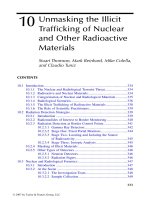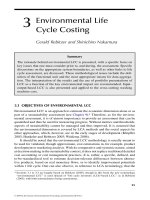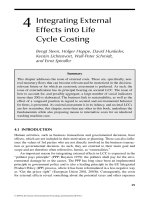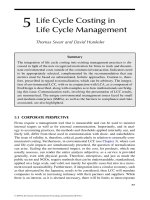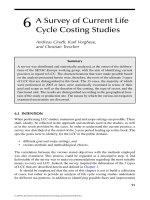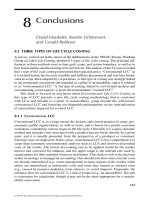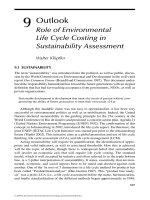Environmental Life Cycle Costing - Chapter 10 pptx
Bạn đang xem bản rút gọn của tài liệu. Xem và tải ngay bản đầy đủ của tài liệu tại đây (3.44 MB, 15 trang )
123
CHAPTER
10
Environmental Fluoride
10.1 INTRODUCTION
Fluorine is the lightest element in Group VII of the periodic table, with atomic
number 9 and an atomic weight of 18.998. It has a single isotope, and its valence
in all naturally occurring compounds is 1. Although fluoride is not listed as one of
the “Criteria Air Pollutants” regulated by the EPA, it is nevertheless a very important
gaseous air pollutant. Indeed, fluoride (F) is the most phytotoxic air pollutant because
it can damage plants at extremely low concentrations. Furthermore, adverse effects
of F are not limited to airborne F; waterborne F at high levels is also injurious to
both human and animal health. For example, in China and India millions of people
are suffering from dental and skeletal fluorosis, an abnormal or poisoned condition
caused by F.
10.2 OCCURRENCE AND FORMS OF FLUORIDE
Fluoride is ubiquitous: it occurs in minerals and soils, air, natural waters, and
foods. The F content in rocks is about 0.06 to 0.09% (by weight). The most important
F-containing minerals and soils are fluorspar or fluorite (CaF
2
), cryolite (Na
3
AlF
6
),
and fluorapatite (Ca
10
F
2
(PO
4
)
6
). The air in U.S. residential and/or rural communities
contains less than 0.04 to 1.2 ppb (0.03 to 0.90 mg F/m
3
). Fluoride content in natural
waters in the U.S. ranges from 0.02 to 0.2 ppm. In 1969, there were 2630 commu-
nities in the United States with a drinking water supply with a natural F concentration
of 0.7 ppm or more (Figure 10.1).
1
River waters contain 0.0 to 6.5 ppm, with an
average of 0.2 ppm. Ground waters contain from 0.1 to 8.7 ppm, depending on the
rocks from which the waters flow. The F level in seawater is about 1.4 ppm.
Virtually all foods contain trace amounts of F. Fluoride-containing foods and
beverages are, therefore, the most important sources of F. The adult intake of F from
LA4154/frame/C10 Page 123 Friday, May 19, 2000 9:27 AM
© 2001 by CRC Press LLC
124 ENVIRONMENTAL TOXICOLOGY
foods in the U.S. is about 0.2 to 0.3 mg per day. The intake from drinking water
ranges from 0.1 to 0.5 mg in nonfluoridated communities, while in fluoridated
communities the intake may amount to 1 to 2 mg/day. The F contents in plants vary
with plant species. Most plants contain 0.1 to 10 ppm F (dry basis), but several
species are known as F accumulators. For instance, tea leaves may contain as high
as 760 ppm F (dry basis). Tea beverage, however, may contain less than 0.5 mg F
per cup. The F contents of some foods are shown in Table 10.1.
10.3 SOURCES OF ENVIRONMENTAL FLUORIDE
Natural sources of waterborne F include volcanism, aerosols from ocean spray,
soil dust blown into the atmosphere, and others. Fluoride emitted into the atmosphere
from volcanoes, industries, and other sources is in both gaseous and particulate
forms. These sources also contribute F to surface waters. Natural waters in some
parts of the world contain high levels of F (from several ppm to more than 20 ppm).
Anthropogenic sources of F emission include a variety of industries, such as primary
aluminum production, phosphate fertilizer and elemental phosphorus plants, primary
iron and steel production, the ceramic industry (tile, brick, glass works, etc.), and
others. In addition, fuel combustion (F in coal: 0.001 to 0.048% in US; average,
0.008%) and solid waste incineration also result in F emission. The forms of F
emitted from industrial processes include hydrogen fluoride (HF), fluorspar, cryolite,
and silicon tetrafluoride (SiF
4
). In addition to deposition into surface waters, airborne
Figure 10.1
Distribution of communities in the United States with 0.7 ppm or more natural
fluoride in community water supply. (Adapted from National Academy of Sci-
ences/National Research Council,
Effects of Fluorides in Animals,
NAS Subcom-
mittee on Fluorosis, Washington, DC, 1974.)
LA4154/frame/C10 Page 124 Friday, May 19, 2000 9:27 AM
© 2001 by CRC Press LLC
ENVIRONMENTAL FLUORIDE 125
F may eventually be deposited onto the ground and taken up by soils, plants, and
animals (Figure 10.2).
10.4 INDUSTRIAL SOURCES OF FLUORIDE IN THE ENVIRONMENT
Several representative industrial sources of F contributing to environment fluo-
ride are discussed here.
10.4.1 Manufacture of Phosphate Fertilizers
The starting material for manufacture of normal superphosphate fertilizer is
phosphate rock composed mainly of fluorapatite. In this process, fluorapatite reacts
with H
2
SO
4
and water, producing CaH
4
(PO
4
)
2
. The overall chemical reaction for the
manufacture is shown in Equation 10.1. Since the F content of the ore is approxi-
mately 3%, a substantial quantity of HF is produced. HF reacts with SiO
2
in the
fluorapatite to form SiF
4
(gas), as shown in Equation 10.2.
Ca
10
F
2
(PO
4
)
6
+ 7H
2
SO
4
+ 3H
2
O
→
3CaH
4
(PO
4
)
2
· H
2
O + 7CaSO
4
+ 2HF (10.1)
SiO
2
+ 4HF
→
SiF
4
+ 2H
2
O (10.2)
(gas)
In the wet scrubber, SiF
4
readily reacts with water, forming fluorosilicic acid:
SiF
4
e + H
2
O
→
H
2
SiF
6
(10.3)
Table 10.1 Fluoride Content of Selected
Foods (ppm on dry basis)
Milk 0.04–0.55
Meats 0.01–7.7
Fish 0.10–24
Cheese 0.13–1.62
Butter 0.4–1.50
Rice and peas 10
Cereal and cereal products 0.10–0.20
Vegetables and tubers 0.10–2.05
Citrus fruits 0.04–0.36
Sugar 0.10–0.32
Coffee 0.2–1.6
Tea infusion 0.1–2.0
Instant (solution) 0.2
Adapted from National Academy of Sci-
ences/National Research Council, Committee
on Biologic Effects of Atmospheric Pollutants,
Fluorides,
Washington DC, 1971.
LA4154/frame/C10 Page 125 Friday, May 19, 2000 9:27 AM
© 2001 by CRC Press LLC
126 ENVIRONMENTAL TOXICOLOGY
Figure 10.2
Environmental transfer of fluoride. (Adapted from National Academ
y of Sciences/National Research Council, Committee on Biologic
Effects
of Atmospheric Pollutants,
Fluorides,
Washington DC, 1971.)
LA4154/frame/C10 Page 126 Friday, May 19, 2000 9:27 AM
© 2001 by CRC Press LLC
ENVIRONMENTAL FLUORIDE 127
10.4.2 Manufacture of Aluminum
Manufacture of aluminum is almost exclusively by the Hall–Herouet process, in
which alumina (Al
2
O
3
) is dissolved in molten cryolite and reduced electrolytically.
The electrolytic cell contains a carbon lining, serving as both the cathode and the
container for the melt. Equation 10.4 shows the chemical reaction:
(10.4)
As seen in the equation, CO and CO
2
are the two gases emitted in the process; it
shows no emission of any F-containing substances. In actuality, however, a number
of those substances are emitted. The reason for this apparent discrepancy is that
various catalysts, including CaF
2
, AlF
3
, and cryolite, are used in the electrolysis of
alumina, and as they are heated to high temperatures, some will escape from the
cells and are emitted into the surrounding atmosphere. In addition to CO and CO
2
shown in Equation 10.4, several other gases such as SO
2
, SiF
4
, HF, COS, CS
2
, He,
and water vapor, are also emitted from the electrolysis cells. A large number of
particulates are also emitted. Examples of the particulates include Al
2
O
3
, carbon,
cryolite, AlF
3
, CaF
2
, Fe
2
O
3
, and
chiolite (Na
5
Al
3
F
14
).
10.4.3 Manufacture of Steel
In the process of manufacturing steel, CaF
2
is used as a flux (a substance used
to promote fusion) in an open-hearth oven to increase the fluidity of the slags and
enhance the removal of impurities, such as phosphorus and sulfur, from the melts.
Fluoride compounds emitted from this operation include HF and CaF
2
.
10.5 EFFECTS ON PLANTS
10.5.1 Toxicological Effects
Hydrogen fluoride is the most phytotoxic air pollutant. It can cause injury to
susceptible plants at concentrations below 1 ppb (0.8
µ
g/m
3
) for exposure periods of
7 days or fewer.
2,3
Fluoride-induced effects in plants may be considered on four levels
of biologic organization: cellular, tissue or organ, organism, and ecosystem (Table
10.2).
4
Fluoride accumulates in plant leaves mainly as a result of diffusion through
the stomata from the atmosphere or through absorption from the soil by the roots. In
contrast to other major air pollutants, such as SO
2
, NO
2
, and O
3
discussed in Chapter
8, F accumulates in the foliage of plants, which serves as a vehicle for its transfer to
herbivores with the potential for inducing dental and skeletal fluorosis.
Fluoride induces both structural and functional changes in plant cells. Changes
occur in cellular and subcellular membranes with subsequent injuries. Although
plants differ widely in their susceptibility to F injury, accumulation of high levels
of F in leaves normally leads to chlorosis and necrosis. Chlorosis is associated with
Al O C
Catalysts
Al CO CO
23 2
22+ →++
LA4154/frame/C10 Page 127 Friday, May 19, 2000 9:27 AM
© 2001 by CRC Press LLC
128 ENVIRONMENTAL TOXICOLOGY
lowered chlorophyll content in the leaf and thus leads to lowered photosynthesis.
Similarly, the destruction of part of the leaf resulting from necrosis will cause a
comparable reduction in photosynthesis. Both chlorosis and necrosis lead to reduced
growth and yield. Tree death could result when the injuries are severe (Figure 10.3A).
Unlike NO
2
or SO
2
, F accumulation occurs in the leaf tips and margins of many
plant species (Figures 10.3B and C). In germinating mung bean seedlings exposed
to varying concentrations of NaF, a concentration-dependent growth inhibition was
observed (Figure 10.4).
During the past several decades, numerous field and laboratory studies have been
conducted on the phytotoxicity of F throughout the world. An interesting case study
is presented here to serve as an example. In 1979 researchers in Taiwan observed a
previously unknown foliage disease on rice plants grown in northern Taiwan. Leaves
of the plants grown in an area adjacent to ceramic and brick industrial facilities
manifested acute symptoms of chlorosis and tip necrosis. Studies done in 1983
showed that ambient F concentration in the area ranged from 0.4 to 15
µ
g/kg
(average, 4.5
µ
g/kg). Analyses of leaf F content in rice leaves grown in the area
revealed marked increases with the increasing severity of the leaf injuries. The
severely injured leaves contained 80 times as much F as the healthy leaves. Subse-
quent laboratory experiments involving fumigation of rice seedlings with HF showed
leaf symptoms similar to those observed in the field. These results suggested to the
researchers that F emitted from the ceramic and brick factories was the cause of the
new rice disease.
5
10.5.2 Biochemical Effect
Fluoride is widely known as a metabolic inhibitor. As such, F affects many
biological processes including glycolysis, Krebs cycle reactions, photosynthesis,
6
protein synthesis, lipid metabolism, and others. Much of the action of F on these
processes can be attributed to F-dependent inhibition of enzymes. Enzymes that are
Table 10.2 Nature of Fluoride-Induced Effects in Plants at Four Levels of Biologic
Organization
Cellular Tissue Organism Ecosystem
Effects on enzymes
and metabolites
Decreased
assimilation
Altered respiration
Increased F in
ecosystem
Modification of cell
organelles and
metabolism
Altered growth and
development
Modified growth Increased F burden
of animals
Pathway disruption Chlorotic lesions Reduced
reproduction
Fluorosis in animals
Cellular modification Necrotic lesions Decreased fitness for
environment
Disruption and death
of cell
Death or abscission
of leaf
Death of plants Desolation
Adapted from National Academy of Sciences/National Research Council, Committee on Biologic
Effects of Atmospheric Pollutants,
Fluorides,
Washington DC, 1971.
LA4154/frame/C10 Page 128 Friday, May 19, 2000 9:27 AM
© 2001 by CRC Press LLC
ENVIRONMENTAL FLUORIDE 129
inhibited include enolase, phosphoglucomutase, phosphatase, hexokinase, PEP car-
boxylase, pyruvate kinase, succinic dehydrogenase, malic dehydrogenase, pyrophos-
phatase, phytase, nitrate reductase, mitochondrial ATPase, and urease.
7
In germinat-
ing mung bean seedlings exposed to NaF at 1 m
M
and above, inhibition of lipase,
8
amylase (Table 10.3),
9
and invertase
10
activities
in vivo
has been observed. Fluoride-
induced inhibition of amylase and invertase appears to involve the removal of cofactor
Ca
2+
by F
–
. Seedlings exposed to 1 m
M
NaF inhibited [2-
14
C]thymidine incorporation
into DNA. The inhibition suggests concomitant changes in protein synthesis.
11
Inhibition of enzymes such as these is often reflected by compositional changes
in plant tissue. For instance, soybean leaves exposed to 30 ppb HF exhibited lowered
sucrose content, while the levels of both glucose and fructose were elevated.
12
In
addition, marked increases in organic acids, such as malic, malonic, succinic, and
citric acids, occurred.
12
The inhibition of amylase
9
and invertase
10
in the germinating
mung bean seedling exposed to NaF, mentioned above, is often accompanied by an
increase in sucrose levels in the root.
Figure 10.3
(Left) An injured fir tree growing in an area adjacent to an aluminum manufac-
turing plant. Analysis of needles from adjacent trees showed F levels at approx-
imately 500 ppm, on dry wt basis. (Top) Pear leaves with tip and marginal
necrosis. (Bottom) Gladiolus leaves with tip necrosis.
LA4154/frame/C10 Page 129 Friday, May 19, 2000 9:27 AM
© 2001 by CRC Press LLC
130 ENVIRONMENTAL TOXICOLOGY
While it is clear that the action of F on plant metabolism is complex and involves
a variety of enzymes, the mode of action of fluoride ion on these enzymes is not so
clear. The principal mechanisms that have been suggested earlier include: (a) for-
mation of complex with metalloenzymes; (b) removal of a metal cofactor such as
Ca or Mg from an enzyme system; and (c) binding to the free enzyme or to the
enzyme substrate complex.
7
Using a model system Edwards et al.
13
showed that F
could disrupt the hydrogen bonding of protein molecules. Because hydrogen bonding
is important in the maintenance of the tertiary structure of protein molecules, dis-
ruption of an enzyme protein by F would lead to enzyme inhibition.
As shown in Chapter 5, SOD is an important antioxidant enzyme. Field and
laboratory studies have shown that SOD activities in different plant tissues exposed
to F were either enhanced or lowered. For instance, mung bean seedlings exposed
to 0.2 m
M
NaF showed increased SOD activity, whereas exposure to 1 m
M
NaF
and above resulted in depressed SOD activity.
14
10.6 EFFECTS ON ANIMALS
Animals normally ingest small amounts of F in their rations without observable
adverse effects, but excessive intake can be detrimental. Fluoride intake increases
Figure 10.4
Effect of NaF on mung bean germination. Seedlings were exposed to 0 (control),
0.1, 1.0, and 5.0 m
M
NaF for 24, 48, and 72 h, respectively. (Yu, M H., unpub-
lished data, 2000.)
Table 10.3 Effects of NaF on
α
-Amylase from
Mung Bean Cotyledon
Specific Activity (nmol/mg/min)
NaF, m
M
48 h
Percent of
Control 72 h
Percent of
Control
0.0 13.1 — 27.8 —
0.1 14.6 111 24.4 88
1.0 11.3 86 24.2 87
5.0 8.3 63 22.2 80
'XUDWLRQRI7UHDWPHQWK
5DGLFOHOHQJWKPP
&RQWURO
P0
P0
P0
LA4154/frame/C10 Page 130 Friday, May 19, 2000 9:51 AM
© 2001 by CRC Press LLC
ENVIRONMENTAL FLUORIDE 131
when animals ingest vegetation or hay contaminated by elevated levels of airborne
F. The effect of F on domestic animals may be acute or chronic, depending on F
concentrations.
10.6.1 Acute Effects
Fluoride and arsenic have caused detrimental effects on livestock in the U.S. and
other industrialized countries. The sources of F pollution are limited mostly to
phosphate-fertilizer manufacturing, aluminum production, fluorohydrocarbon, and
heavy metal production. Safe levels of soluble F in animal rations range from 30 to
50 mg/kg for cattle and from 70 to 100 mg/kg for sheep and swine. Such physio-
logical effects as gastroenteritis, muscular weakness, pulmonary congestion, nausea,
vomiting, diarrhea, chronic convulsions, necrosis of the mucosa of the digestive
tract, anorexia, cramping, collapse, and respiratory and cardiac failure may occur,
followed by death.
10.6.2 Chronic Effects
The two most conspicuous and thoroughly studied manifestations of chronic F
poisoning are dental and skeletal fluorosis. Once absorbed into the animal body, F
has a great affinity for developing and mineralizing teeth. Such affinity of fluorides
can either enhance tooth development or induce dental lesions, depending on the
amount of fluorides ingested. Dental lesions are manifested by abnormal enamel
matrix, such as in chalkiness, mottling, and hypoplasia (a thin enamel). An affected
tooth is also subject to more rapid wear and to erosion of the enamel away from the
dentin. It is noteworthy that dental lesions will not be seen in animals brought into
endemic fluorosis areas after their permanent teeth have erupted.
15
Recent studies indicate a widespread chronic effect of environmental fluoride
on wildlife. Fluoride contamination of vegetation has arisen from various industrial
activities and the combustion of coal. Studies done by European scientists indicate
a large number of deer in various European countries suffer from both dental and
skeletal fluorosis.
16,17
Improvement has been made in controlling F emission in the
past three decades. Comparative field studies show that F contamination of vegetation
in recent years has decreased significantly, with concomitant decreases in F levels
in dental and skeletal samples from wild animals.
Studies on deer populations affected by F are relatively limited in the United
States. Perhaps there is little active research in this area because atmospheric F
pollution is not considered a serious environmental pollution problem in the U.S.
Nevertheless, one study has indicated the impact of airborne F on wildlife. Figures
10.4A and B show a comparison between marked dental disfigurement and the
abnormal tooth wear pattern of a female black-tailed deer (deer A) (Figure 10.4A)
and the normal tooth wear pattern of another deer (deer B) (Figure 10.4B). Deer A
was killed on a road near an aluminum manufacturing plant, whereas deer B was
killed on a road in an area with no industrial facilities. Analysis of the F content in
bone samples from these two animals showed that the F levels of the bone from
deer A were 15 to 20 times higher than those of the bone from deer B.
18
LA4154/frame/C10 Page 131 Friday, May 19, 2000 9:27 AM
© 2001 by CRC Press LLC
132 ENVIRONMENTAL TOXICOLOGY
In addition to inducing tooth mottling, F can also cause skeletal fluorosis. In this
case, the affected bones lose their normal, hard, smooth luster and appear rough,
porous, and chalky white. A generalized hyperostosis (excessive formation of bone
tissue, especially in the skull) and, in some cases, exostotic lesions of the otherwise
smooth, long bones may be observed (
Note:
Exostosis is a spur or bony outgrowth
from a bone.) Lameness or stiffness is an intermittent sign of F toxicity. The clinical
basis for the lameness is not well understood.
Appetite is normally impaired, and this may result in decreased weight gain,
cachexia, and lower milk yield. Decline in milk production may be secondary to
appetite impairment or other responses. Evidence that animals may be suffering
chronic F effect may be obtained from chemical analysis of the feed and elevated
levels of F in urine and body tissues.
19
Other effects include increased susceptibility
to other environmental stresses and decrease in longevity.
A number of factors influence the manifestation of dental and skeletal fluorosis.
For example, the amount and the bioavailability of F ingested; duration of ingestion;
species of animals involved (Table 10.4); age at time of excessive F ingestion;
nutritional and general health status of animals; mode of F exposure (e.g., contin-
uous or intermittent); presence of synergistic or antagonistic substances; presence
of other stress factors, such as those caused by poor management; and individual
biologic response.
Fluoride inhibits the metabolism of carbohydrates, lipids, and proteins. In ani-
mals and humans, a large number of enzymes are depressed by F, including enolase,
adenylcyclase, lipase, and cholinesterase. Inhibition of glycolysis, due in part to
decreased enolase activity, may be responsible for the hyperglycemia observed in
experimental animals. Several nutrients, such as proteins, Ca, and vitamin C, influ-
ence the severity of F toxicity. The adverse effect of F is often alleviated by these
nutrients. For example, both vitamin C and Ca have been shown to decrease the
toxicity in guinea pigs.
20
Protein nutrition is also important in affecting F accumu-
lation in experimental animals. Mice fed a low-protein (4%) diet deposited 500%
more F in tibia than did control animals fed a regular diet containing 27% protein.
Furthermore, supplemental vitamin C greatly lowered F deposition in the bone.
21
It
Table 10.4 Fluoride Tolerances (in ppm) in Livestock Diets
Breeding or
Lactating Animals Finishing Animals
Dairy and beef heifers 30 100
Dairy cows 30 100
Beef cows 40 100
Sheep 50 160
Horses 60 —
Swine 70 —
Turkeys — 100
Chickens 150 —
Adapted from National Academy of Sciences/National Research
Council, Committee on Biologic Effects of Atmospheric Pollutants,
Fluorides, Washington DC, 1971.
LA4154/frame/C10 Page 132 Friday, May 19, 2000 9:27 AM
© 2001 by CRC Press LLC
ENVIRONMENTAL FLUORIDE 133
should be mentioned that mice produce vitamin C as well. The effect of fluoride on
a number of enzymes is markedly influenced by the nutritional status of the exposed
animals. For instance, da Motta et al.
22
studied the effects of subtoxic dose of a NaF
(10 mg F/kg body weight) on the activities of glucose-6-phosphate dehydrogenase
(G6PD) in the submandibular glands of fed and overnight-fasted rats and observed
that the enzyme activities in the fasted animals were significantly decreased, but the
fed animals did not manifest the decreases.
10.7 EFFECTS ON HUMANS
10.7.1 Daily Intake
Daily intake of F from food is about 0.2 to 0.3 mg; from water 0.1 to 0.5 mg
(1 to 2 mg if water is fluoridated); and varying quantities from beverages (F content
of wine, 0 to 6.3 ppm; beer, 0.15 to 0.86 ppm; milk, 0.04 to 0.55 ppm). The amount
of F inhaled from air is about 0.05 mg/day.
10.7.2 Absorption
Absorption of F from the gastrointestinal tract occurs through a passive process;
it does not involve active transport. Absorption is rapid and probably occurs in the
lumen. The rate of absorption depends on the F-compounds involved, e.g., NaF, 97%;
Ca
10
F
2
(PO
4
)
6
, 87%; Na
3
AlF
6
, 77%; and CaF
2
, 62%. About 50% of the absorbed F is
excreted by the kidneys, while the remainder is stored primarily in calcified tissues.
No significant F accumulation occurs in soft tissues. Almost all of the remaining
50% of absorbed F is fixed in bone. Bone has a great affinity for F and incorporates
it into hydroxyapatite (Ca
10
(OH)
2
(P0
4
)
6
), forming fluorapatite (Ca
10
F
2
(P0
4
)
6
). Even
at low levels of F intake, appreciable amounts of F will in time accumulate in calcified
tissues. The effectiveness of low levels of F intake in reducing dental caries in
humans, rats, and some other species has been reported. In human populations, a
water supply containing 1ppm F is reported to reduce dental caries incidence more
than 50% in individuals who consume F from infancy. Fluoride is incorporated into
tooth mineral as fluorapatite at the time of calcification.
10.7.3 Acute Effects
Exposure to high levels of F results in severe injuries. The lethal dose of inorganic
F has been estimated to be in the range of 2.5 to 5 g for a 70-kg man, or approximately
50 mg/kg, a dose similar to the LD
50
for several animal species. The cause of death
is probably related to the prompt binding of serum Ca and Mg by F. Clinical
symptoms include excessive salivation, perspiration, nausea, painful spasms of
limbs, stiffness, chronic convulsion, necrosis of the mucosa of the digestive tract,
and heart failure.
LA4154/frame/C10 Page 133 Friday, May 19, 2000 9:27 AM
© 2001 by CRC Press LLC
134 ENVIRONMENTAL TOXICOLOGY
10.7.4 Chronic Effects
Fluoride accumulates in the skeleton during prolonged, high-level exposures.
Radiological evidence of hypermineralization (osteofluorosis) is shown when bone
Figure 10.5 (A) Dental disfigurement and abnormal tooth wear patterns in a black-tailed
deer killed in an area adjacent to an aluminum plant. (Female, ca. 1.5 yr old.)
(B) Normal tooth wear patterns of a black-tailed deer killed in an area with no
industrial facilities. (Male, ca. 2.5 yr old.)
LA4154/frame/C10 Page 134 Friday, May 19, 2000 9:27 AM
© 2001 by CRC Press LLC
ENVIRONMENTAL FLUORIDE 135
concentrations reach about 5000 ppm F.
19
Coupled with other environmental factors,
such as nutrition and health status, patients may suffer severe skeletal dysfunction.
In addition, vomiting and neurological complaints have been reported. The levels
of serum and urinary F usually rise. Fluoride exposure leads to cell damage and
induces necrosis. Eventually, F produces massive impairment in the functions of
vital organs, particularly when given orally.
In parts of the world, such as India and China where in many villages the water
supply (from wells) contains high levels of F (in some cases as high as 20 ppm),
osteofluorosis is common. Published reports indicate that in China about 20 million
people may be afflicted by chronic F poisoning.
23
It should be mentioned that, with
growing awareness and the effort made by governments and residents in recent years,
much progress has been made in the control of F poisoning in many afflicted areas.
10.7.5 Biochemical Effect
Fluoride stimulates adenylcyclase activity in all tissues so far examined. Similar
to the observations in plants discussed earlier, F affects functions controlled by Ca
in humans. These include blood clotting, membrane permeability, nervous system
functions, and cholinesterase activity. Inhibitory effects of F in many reactions
involving Ca are generally considered to be due to CaF
2
formation, as depicted below:
[Protein-Ca] ↔ Protein + Ca
2+
(10.5)
Ca
2+
+ F
–
↔ [CaF]
+
+ F
–
↔ CaF
2
(10.6)
Fluoride also mediates enzyme systems requiring Mg, or in reactions involving
phosphorus. In this case, it is suggested that F forms a magnesium–fluorophosphate
complex.
As previously mentioned, F has been shown to inhibit protective enzymes such
as SOD, GSHPx, and catalase in various human tissues. Inhibition of one or more
of these enzymes may allow more free radical-induced reactions to occur, leading
to cellular and tissue damage. As noted earlier, a number of researchers have used
antioxidants, such as vitamins E and C, β-carotene, and GSH, to ameliorate injuries
induced by excessive levels of F.
10.8 REFERENCES AND SUGGESTED READINGS
1. National Academy of Sciences/National Research Council, Effects of Fluorides in
Animals, NAS Subcommittee on Fluorosis, Washington, DC, 1974, 4.
2. Weinstein, L.H., Effects of fluorides on plants and plant communities: an overview,
in Fluorides: Effects on Vegetation, Animals, and Humans, Proceedings, Second
International Symposium on Fluorides, May 24–27, 1982, Shupe, J.L., Peterson, H.B.,
and Leone, N.C., Eds., Paragon Press, Salt Lake City, UT, 1983, 53.
3. Madkour, S. and Weinstein, L.H., Effects of hydrogen fluoride on incorporation and
transport of photoassimilates in soybean, Environ. Toxicol. Chem., 6, 627, 1987.
LA4154/frame/C10 Page 135 Friday, May 19, 2000 9:27 AM
© 2001 by CRC Press LLC
136 ENVIRONMENTAL TOXICOLOGY
4. National Academy of Sciences/National Research Council, Committee on Biologic
Effects of Atmospheric Pollutants, Fluorides, Washington DC, 1971, 295.
5. Sun, E.J. and Su, H.J., Fluoride injury to rice plants caused by air pollution emitted
from ceramic and brick factories, Environ. Pollut. (Series A), 37, 335, 1985.
6. McLaughlin, S.B. et al., Effects of chronic air pollution stress on photosynthesis,
carbon allocation, and growth of white pine trees (Pinus strobus), For. Sci., 28, 60,
1982.
7. Miller, G.W., Yu, M.H., and Pushnik J.C., Basic metabolic and physiologic effects of
fluorides on vegetation, in Fluorides: Effects on Vegetation, Animals, and Humans,
Proceedings, Second International Symposium on Fluorides, May 24–27, 1982,
Shupe, J.L., Peterson, H.B., and Leone, N.C., Eds., Paragon Press, Salt Lake City,
UT, 1983, 83.
8. Yu, M.H., Young, R., and Sepanski, L., Inhibition of lipid metabolism in germinating
mung bean seeds by fluoride, Fluoride, 20, 113, 1987.
9. Yu, M.H., Shumway, M.O., and Brockbank, A., Effects of NaF on amylase in mung
bean seedlings, J. Fluorine Chem., 41, 95, 1988.
10. Yu, M.H., Effects of sodium fluoride on soluble sugars and invertase in germinating
mung bean (Vigna radiata) seeds, Environ. Sci., 5, 121, 1997.
11. Narita, A. et al., Fluoride inhibition of [2-
14
C]thymidine incorporation into DNA in
mung bean seedlings, Fluoride, 29, 72, 1996.
12. Yang, S.F. and Miller, G.W., Biochemical studies on the effect of fluoride on higher
plants: 1. Metabolism of carbohydrates, organic acids and amino acids, Biochem. J.,
88, 505, 1963.
13. Edwards, S.L., Poulos, T.L., and Kraut, J., The crystal structure of fluoride-inhibited
cytochrome c peroxidase, J. Biol. Chem., 259, 12984, 1984.
14. Wilde, L.G. and Yu, M.H., Effect of fluoride on superoxide dismutase (SOD) activity
in germinating mung bean seedlings, Fluoride, 31, 81, 1998.
15. Shupe, J.L. and Olson, A.E., Clinical and pathological aspects of fluoride toxicosis
in animals, in Fluorides: Effects on Vegetation, Animals, and Humans. Proceedings,
Second International Symposium on Fluorides, May 24–27, 1982, Shupe, J.L., Peter-
son, H.B., and Leone, N.C., Eds., Paragon Press, Salt Lake City, UT, 1983, 319.
16. Kierdorf, H., Kierdorf, U., and Sedlacek, F., Biomonitoring of fluoride contamination
of wild ruminant habitats in northern Bohemia (Czech Republic), Zeitsch. Jagdwis.,
42, 41, 1996.
17. Vikoren, T., Stuve, G., and Froslie, A., Fluoride exposure in cervids inhabiting areas
adjacent to aluminum smelters in Norway. 1. Residue levels, J. Wildlife Dis., 32, 169,
1996.
18. Newman, J.R. and Yu, M.H., Fluorosis in black-tailed deer, J. Wildlife Dis., 12, 39,
1976.
19. Parker, C.M., Sharma, R.P., and Shupe, J.L., The interaction of dietary vitamin C,
protein, and calcium with fluoride: effects in guinea pigs in relation to breaking
strength and radio density of bone, Clin. Toxicol., 15, 301, 1979.
20. Hodge, H.C. and Smith, F.A., Biological Properties of Inorganic Fluorides. Vol. IV,
Simmons, J.H., Ed., Academic Press, New York, 1965, 12.
21. Yu, M.H. and Hwang, S.H.L., Influence of protein and ascorbic acid on fluoride-induced
changes in blood composition and skeletal fluoride deposition in mice, in Fluoride
Research 1985, Tsunoda, H. and Yu, M.H., Eds., Elsevier, Amsterdam, 1986, 203.
22. Da Motta, M.V., de Souza, D.N., and Nicolau, J., Effects of subtoxic doses of fluoride
on some enzymes of the glucose metabolism in submandibular salivary glands of fed
and overnight-fasted rats, Fluoride, 32, 20, 1999.
LA4154/frame/C10 Page 136 Friday, May 19, 2000 9:27 AM
© 2001 by CRC Press LLC
ENVIRONMENTAL FLUORIDE 137
23. Yu, M.H. and Tsunoda, H., Environmental fluoride problems in China, Fluoride, 21,
163, 1988.
10.9 REVIEW QUESTIONS
1. Why is fluoride the most phytotoxic among the major air pollutants?
2. What are the most important F-containing minerals?
3. List three industrial operations that result in atmospheric F emission.
4. What is the reason for fluoride emission in the aluminum manufacturing
process?
5. What is the characteristic leaf injury manifested by plants exposed to fluoride?
6. How does fluoride affect seed germination?
7. Explain the dental lesion manifested by animals/humans suffering chronic
fluoride poisoning.
8. What effect does vitamin C have on fluoride toxicity in animals and/or
humans?
9. Of the following, which compound has the highest rate of absorption? And,
the lowest rate of absorption? (a) NaF; (b) cryolite; (c) CaF
2
; (d) fluorapatite
10. What is the suggested mode of action for fluoride?
11. How is fluoride related to the protective enzymes?
12. How is fluoride toxicity related to tissue Ca levels?
LA4154/frame/C10 Page 137 Friday, May 19, 2000 9:27 AM
© 2001 by CRC Press LLC
